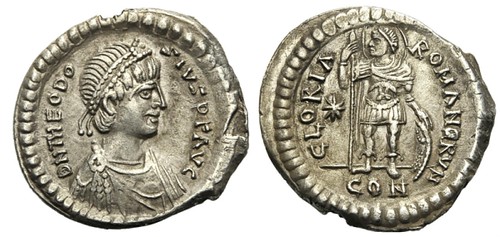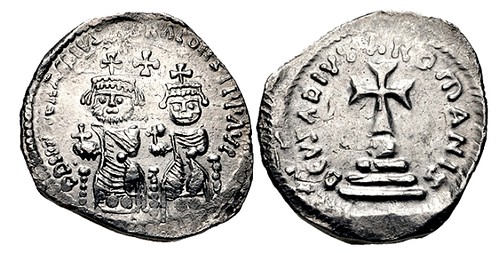
PREV ARTICLE
NEXT ARTICLE
FULL ISSUE
PREV FULL ISSUE
THE PARADOX OF BYZANTINE SILVER
Mark Markowitz published another article June 12, 2015 in his CoinWeek Ancient Coin Series on The Paradox of Byzantine
Silver. Here's an excerpt. -Editor
The position of silver in the hierarchy of metals struck during the sixth century was a curious one. In the East, the currency in ordinary circulation consisted entirely of gold and copper. Though a number of silver coins of different types and modules have survived, they have usually done so only in twos or threes; several indeed are known only from unique specimens. -- Philip Grierson, Byzantine Coins (1982) GOLD IS SCARCE. SILVER? Not so much. We expect silver coins to be more abundant and less valuable than gold ones. In the ancient world the silver/gold ratio fluctuated within a fairly narrow band – between 10:1 and 14:1. But for the Eastern Roman Empire (which we call “Byzantine”), this assumption breaks down; paradoxically, gold is often common and silver is usually scarce, sometimes almost non-existent. For example, the vast British Museum collection database reports only 112 hits for “coin, silver, Constantinople, AD 610-1000.” The American Numismatic Society’s (ANS’s) collection of some 13,000 Byzantine coins included only 289 examples of silver for the period AD 500-1000, and many of these are tiny fractional denominations from Western mints. During the terrible third century AD (CE), the Roman economy experienced ruinous inflation and the currency was gradually debased, becoming mostly copper alloy with a trace of silver. At the beginning of the fourth century there was a recovery, with the return of a high-quality silver coin–the argenteus (issued 294-310)–at a weight of 96 to the Roman pound. Over several decades, the standard shrank to 144 to the pound, but the metal remained quite good. It was probably still called an argenteus but modern numismatists call it a silique, after a small unit of weight that was the equivalent value in gold. During the fourth century the empire lost control over silver mines in Spain, Britain, and the Balkans. The rise of Christianity as the state religion “immobilized” tons of silver in the form of altar vessels and church fittings. By the year 500, silver disappeared as part of the regular currency.
Here are just a couple of the several great examples of Byzantine silver coins pictured in the article. -Editor
The Miliarense

With the high-value gold solidus ... as the basis of the currency, alongside an ever-changing variety of low-value coppers, small change was a big problem. Imagine modern Americans facing a cash-only economy consisting mainly of hundred dollar bills at one end (with a few fifties and twenties,) and nickels, dimes and quarters at the other. As part of his currency reforms, Constantine introduced a fine silver coin called the miliarense (from the Latin miliarensis (meaning “of a thousand”), because a thousand of these coins roughly equaled the value of a pound of gold, a unit used to express large sums such as the salaries of officials). There were two versions: a “light” miliarense struck at 72 to the pound, and a “heavy” 60 to the pound. One gold solidus was worth 14 heavies or 18 lights. Miliarenses were handsome, well-made coins, and many surviving specimens are pierced for wear as ornaments or amulets[6]. A typical obverse design was the emperor’s portrait, while the reverse often showed his standing figure in military garb, striking a noble pose and surrounded by the Latin motto GLORIA ROMANORUM (“Glory of the Romans.”) The Hexagram

At the beginning of the seventh century, the Empire was in deep, deep trouble. When Heraclius overthrew the tyrannical Phocas (602 – 610), the frontiers were collapsing and the treasury was nearly empty. In 614 the Persians captured Jerusalem, seizing the most precious relic of the Orthodox Church: the True Cross, supposedly discovered by St. Helena, mother of Constantine the Great, in 326 CE. The Persians soon occupied Egypt, the empire’s richest province. Short of gold to pay both his troops and imperial officials, in 615 Heraclius introduced an emergency silver coin, the hexagram. Struck at a standard of 48 to the pound (6.8 grams), and valued at 12 to the gold solidus, the coin bore the image of Heraclius and his infant son Heraclius Constantine enthroned side by side. Over the next 23 years, the son gradually gets bigger and bigger, and is eventually bearded. The reverse bore a cross over a globe above three steps, with the Latin invocation DEUS ADIUTA ROMANIS (“O God, Assist the Romans.”) A very rare half-hexagram is known from only two examples. A few hexagrams were struck at Ravenna in Italy, but the coin never caught on in the western provinces, where tiny silver coins like the “quarter siliqua” were preferred. A new design appeared in 638 when a second son, Heraclonas, was crowned as co-emperor. Considerably more rare (only issued for three years), it shows the three rulers standing together. Numismatic Literature
The standard reference for Byzantine coinage is the massive and costly Dumbarton Oaks Catalogue (1966 – 1999, commonly abbreviated as “DOC”) in five volumes. David Sear’s Byzantine Coins and Their Values (1987) is affordable, and essential to the serious collector, but becoming outdated. The only book about hexagrams, Yannopoulos (1978) in French, is hard to find. To read the complete article, see:
Wayne Homren, Editor The Numismatic Bibliomania Society is a non-profit organization promoting numismatic literature. See our web site at coinbooks.org. To submit items for publication in The E-Sylum, write to the Editor at this address: whomren@gmail.com To subscribe go to: https://my.binhost.com/lists/listinfo/esylum All Rights Reserved. NBS Home Page Contact the NBS webmaster 
|